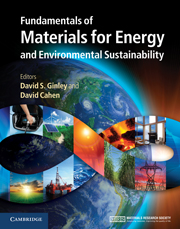Book contents
- Frontmatter
- Contents
- Contributors
- Preface
- Acknowledgments
- Part 1 Energy and the environment: the global landscape
- Part 2 Nonrenewable energy sources
- Part 3 Renewable energy sources
- Part 4 Transportation
- Part 5 Energy efficiency
- 35 Lighting
- 36 Energy efficient buildings
- 37 Insulation science
- 38 Industrial energy efficiency: a case study
- 39 Green processing: catalysis
- 40 Materials availability and recycling
- 41 Life-cycle assessment
- Part 6 Energy storage, high-penetration renewables, and grid stabilization
- Summary
- Appendix A Thermodynamics
- Appendix B Electrochemistry
- Appendix C Units
- Index
- References
41 - Life-cycle assessment
from Part 5 - Energy efficiency
Published online by Cambridge University Press: 05 June 2012
- Frontmatter
- Contents
- Contributors
- Preface
- Acknowledgments
- Part 1 Energy and the environment: the global landscape
- Part 2 Nonrenewable energy sources
- Part 3 Renewable energy sources
- Part 4 Transportation
- Part 5 Energy efficiency
- 35 Lighting
- 36 Energy efficient buildings
- 37 Insulation science
- 38 Industrial energy efficiency: a case study
- 39 Green processing: catalysis
- 40 Materials availability and recycling
- 41 Life-cycle assessment
- Part 6 Energy storage, high-penetration renewables, and grid stabilization
- Summary
- Appendix A Thermodynamics
- Appendix B Electrochemistry
- Appendix C Units
- Index
- References
Summary
Focus
Life-cycle assessment (LCA) evaluates the energy and material requirements and resulting environmental impacts of a product or process over its entire life cycle from raw-material extraction to disposal. This examination across the life cycle provides a systems perspective that can aid decision making for product optimization, product selection, and supply-chain management.
Synopsis
Life-cycle assessment evaluates the environmental impacts of a product or process over its entire life cycle. It can provide an environmental profile of a system or process through the evaluation of inputs, outputs, and potential environmental impacts. There are generally two approaches to conducting an LCA, namely, a process-oriented approach and an economic input–output approach. In a process-oriented assessment, the inputs and outputs are itemized for each step in the process. Specifically, the five steps considered are raw-material acquisition or extraction, material processing, product manufacturing, use, and recovery and retirement. An optional transportation stage can also be added. In contrast, the latter type of assessment considers the required materials and energy resources (inputs) of a process to estimate the resulting environmental emissions (outputs).
- Type
- Chapter
- Information
- Publisher: Cambridge University PressPrint publication year: 2011

